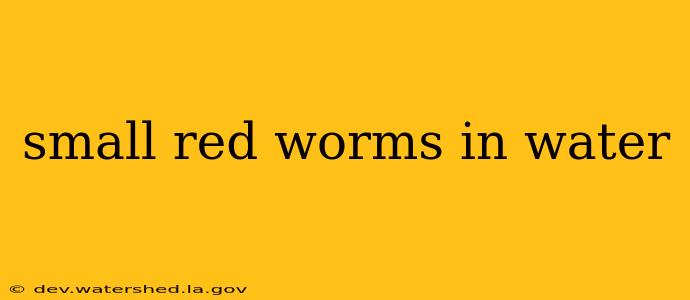Discovering small red worms in your water can be alarming. This guide will help you identify these tiny intruders, understand why they're there, and most importantly, how to get rid of them. We'll explore various scenarios, from aquarium infestations to issues with your home's water supply.
What Kind of Small Red Worms Are They?
This is the crucial first step. Several types of small red worms can appear in water, each with different implications. Accurate identification is key to effective treatment. Some common culprits include:
-
Tubifex worms: These are often found in polluted water sources, appearing as thin, bright red worms wriggling in the sediment. They're relatively harmless to humans but indicate poor water quality.
-
Bloodworms (Chironomus larvae): These are the larval stage of non-biting midges. They are reddish-brown to bright red and are commonly found in aquariums and stagnant water. While generally harmless, large populations can indicate an imbalance in the ecosystem.
-
Red Planarian worms: These flatworms are typically smaller and more translucent than other red worms. They can be problematic in aquariums, consuming fish eggs and even small fish.
-
Other Nematodes: Various nematode species can also appear red and live in water. Identifying these often requires microscopic examination.
Why Are There Small Red Worms in My Aquarium?
Aquarium owners often encounter these uninvited guests. Overfeeding, decaying organic matter, and poor water changes are common culprits. The presence of red worms in an aquarium doesn't automatically signal disaster, but it's an indication that something needs attention.
What causes an overpopulation of red worms in my aquarium?
Overfeeding is a primary cause. Excess fish food provides ample sustenance for worm populations to boom. Poor water changes allow waste and decaying matter to accumulate, creating an ideal breeding ground. Insufficient filtration further exacerbates these conditions.
Why Are There Small Red Worms in My Tap Water?
Finding small red worms in your tap water is less common but can be unsettling. This suggests a problem with your water supply, potentially indicating contamination upstream. Contact your local water authority immediately if you observe this. They can perform water quality tests to pinpoint the source of the contamination and implement corrective measures.
Can these worms be harmful if I drink the water?
The potential health risks depend entirely on the type of worm. While most are unlikely to cause direct harm through ingestion, their presence is a serious indicator of water contamination. It's best to avoid drinking the water until the source of the contamination is identified and rectified. Boiling the water may kill the worms, but it won't necessarily remove any harmful contaminants.
How to Get Rid of Small Red Worms in Water
The solution depends on the source and type of worm.
-
Aquarium: Regular partial water changes, careful feeding, and efficient filtration are crucial preventative measures. If you already have a significant infestation, a thorough cleaning of the tank, gravel, and decorations may be necessary. Biological filtration can also help control populations by introducing beneficial bacteria.
-
Tap Water: Contact your local water authority. They'll investigate the source and implement remediation strategies. Do not attempt to treat the problem independently.
Are there any natural ways to get rid of red worms in an aquarium?
Introducing predatory snails or fish that consume worms can help naturally control their population. Maintaining good water quality and preventing overfeeding are the most effective long-term solutions.
This information is for general guidance only. Always consult with professionals for diagnosis and treatment. Remember, prompt action and correct identification are crucial for resolving the issue effectively and safely.
